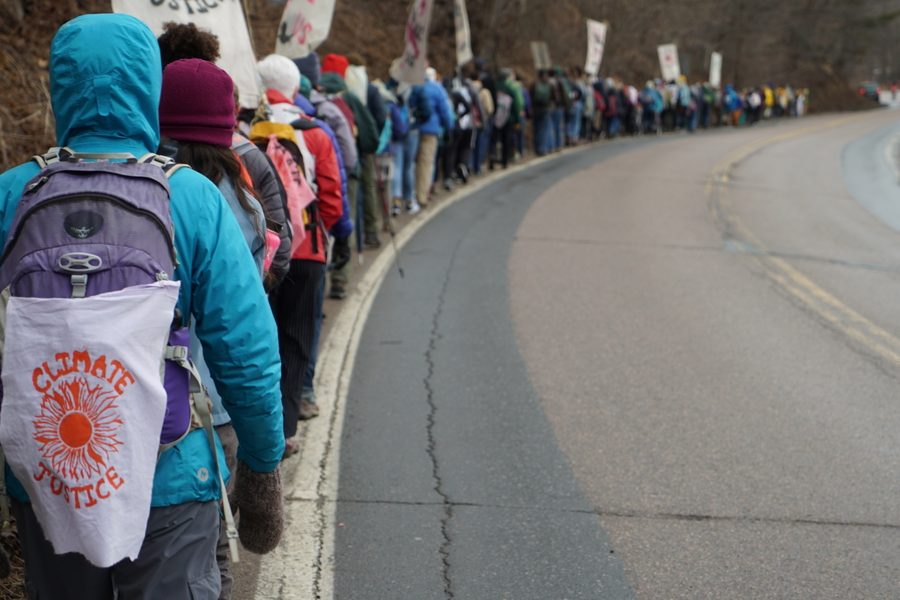Vermonters Marched 65 Miles for Climate Justice
Vermont could become the first state to ban future fossil fuel infrastructure
Olivia Box

MONTPELIER, VT. — On April 9, after a five-day, 65-mile walk from Middlebury, approximately 350 activists, from toddlers to octogenarians, stood silently with their fists in the air at the Vermont State House to demand legislators ban fossil fuel infrastructure development.
The walk, called Next Steps, was organized by 350Vermont (350VT), a nonprofit that advocates for climate justice, to persuade state legislators to pass bills H.51, S.66 and H.175. Bills H.51 and S.66 would ban future fossil fuel infrastructure statewide, while H.175 would ban the use of eminent domain (seizing private property for public use) for fossil fuel projects. 350VT and its allied walk sponsors, including Migrant Justice, Sierra Club-VT Chapter and Sunrise Middlebury, hope Vermont will follow Portland, Ore., and Portland, Maine, which passed similar measures in 2015 and 2018, respectively.
The fight comes at a moment when many states are at odds with the federal government over pipeline construction. One Trump administration executive order tries to accelerate fossil fuel projects by limiting state environmental reviews. If the bills pass, Vermont will become the first state to ban such construction.
While legislators were in session upstairs, around 90 young people marched into the lobby of the statehouse carrying pussy willows gathered during the walk. Protesters had tied paper tags to the plants with their written demands for climate justice, which they read aloud.
“Please preserve Vermont to assure our children will know clean air and water, not desperation, despair, drought and pollution,” one read.
Vermont Gas Systems’ 41-mile pipeline, finished in 2017, delivers fracked gas from the TransCanada Mainline in Alberta to Middlebury. Protesters marched through the areas that could be affected by future distribution lines in Addison County.
Events were planned along the route to celebrate ongoing climate actions, including an interfaith ceremony in Geprags Park in Hinesburg, where the initial pushback against the Vermont pipeline began while it was still under construction. In 2016, activists protested the last 2,000 feet of the pipeline, temporarily delaying its construction. That same year, members of the grassroots group Protect Geprags Park brought photographs to a local public utilities commission meeting showing the unfinished pipeline was not dug deep enough, violating federal regulations and putting the surrounding wetlands at risk. The plaintiffs claimed that the pipelines could “produce explosions with catastrophic effects” if damaged. An ongoing investigation will determine whether the construction followed state safety standards.
The Next Steps walk passed through Bristol on its second day to celebrate the successful blocking of planned distribution lines there. In 2018, 37 residents sued Vermont Gas and the town select board for not holding a public vote regarding the construction. On March 18, the town voted to cease their agreement with Vermont Gas.
“The organizations that are creating most of the problem are absolved from any responsibility … that’s injustice,” said Melanie Brotz, 55, an artist from Burlington whose work appears in pamphlets for 350VT. Brotz walked all five days and was joined by her 17-year-old daughter for four. “We’ve seen some of the effects here, like super extreme weather situations. We have to think about everyone.”
Brotz refers to the walk as “a kind of spiritual pilgrimage,” adding, “There were a lot of churches that were supporting us.”
Tara Bossard-Kruger, 14, of Dummerston, walked all five days and notes the energy and passion of the crowd. At the end of a tiring day, people weren’t moaning and groaning, she said. “They would be singing … and planning.”
Julie Macuga, 27, 350VT’s extreme energy field organizer, hopes the bills will pass but argues Vermont still needs stricter water quality laws and should prohibit the use of eminent domain for fossil fuel projects.
After the rally at the statehouse, protesters gathered for a closing ceremony inside Christ Episcopal Church in downtown Montpelier, where Beverly Little Thunder, 72, a member of the Standing Rock Lakota tribe, gave opening remarks. Little Thunder, of Huntington, is a longtime volunteer with 350VT and the Peace and Justice Center, and walked all five days. She previously walked from San Francisco to Washington, D.C., in the 1978 Longest Walk for Native American rights.
“If we don’t start acting really soon, there will be nothing there for these children. … The young people recognize that and are willing to put themselves in a place of discomfort to bring attention to it,” Little Thunder said.
Ending with a prayer, Little Thunder reminded her fellow activists: “Blisters heal, but the Earth cannot.”





